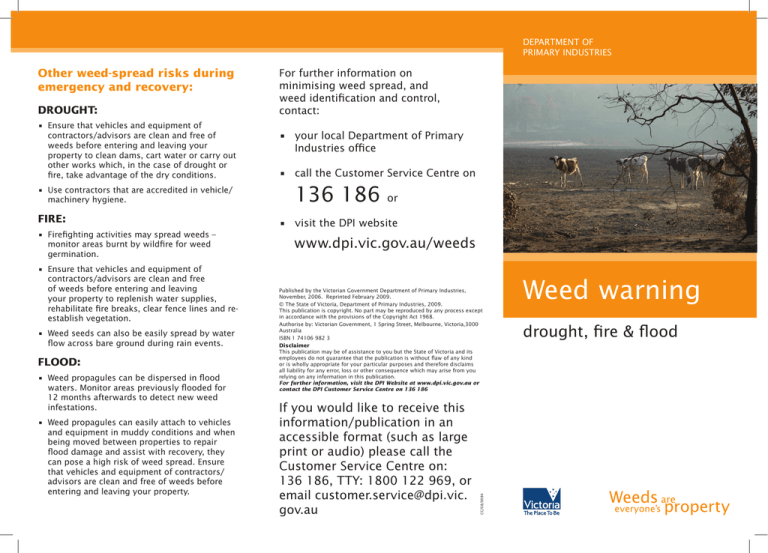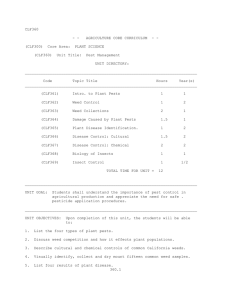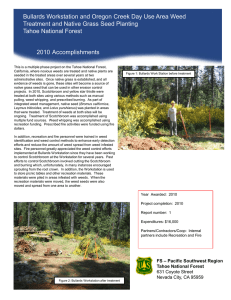Weed Warning: Drought, Fire and Flood
advertisement

DEPARTMENT OF PRIMARY INDUSTRIES DROUGHT: • Ensure that vehicles and equipment of contractors/advisors are clean and free of weeds before entering and leaving your property to clean dams, cart water or carry out other works which, in the case of drought or fire, take advantage of the dry conditions. • Use contractors that are accredited in vehicle/ machinery hygiene. FIRE: • Firefighting activities may spread weeds – monitor areas burnt by wildfire for weed germination. • Ensure that vehicles and equipment of contractors/advisors are clean and free of weeds before entering and leaving your property to replenish water supplies, rehabilitate fire breaks, clear fence lines and reestablish vegetation. • Weed seeds can also be easily spread by water flow across bare ground during rain events. FLOOD: • Weed propagules can be dispersed in flood waters. Monitor areas previously flooded for 12 months afterwards to detect new weed infestations. • Weed propagules can easily attach to vehicles and equipment in muddy conditions and when being moved between properties to repair flood damage and assist with recovery, they can pose a high risk of weed spread. Ensure that vehicles and equipment of contractors/ advisors are clean and free of weeds before entering and leaving your property. For further information on minimising weed spread, and weed identification and control, contact: • your local Department of Primary Industries office • call the Customer Service Centre on 136 186 or • visit the DPI website www.dpi.vic.gov.au/weeds Published by the Victorian Government Department of Primary Industries, November, 2006. Reprinted February 2009. © The State of Victoria, Department of Primary Industries, 2009. This publication is copyright. No part may be reproduced by any process except in accordance with the provisions of the Copyright Act 1968. Authorise by: Victorian Government, 1 Spring Street, Melbourne, Victoria,3000 Australia ISBN 1 74106 982 3 Disclaimer This publication may be of assistance to you but the State of Victoria and its employees do not guarantee that the publication is without flaw of any kind or is wholly appropriate for your particular purposes and therefore disclaims all liability for any error, loss or other consequence which may arise from you relying on any information in this publication. For further information, visit the DPI Website at www.dpi.vic.gov.au or contact the DPI Customer Service Centre on 136 186 If you would like to receive this information/publication in an accessible format (such as large print or audio) please call the Customer Service Centre on: 136 186, TTY: 1800 122 969, or email customer.service@dpi.vic. gov.au CC/08/0084 Other weed-spread risks during emergency and recovery: Weed warning drought, fire & flood DEPARTMENT OF PRIMARY INDUSTRIES The Problem What can you do? The risk of weed invasion, and their impact on farms and the environment dramatically increases during and after an emergency such as drought, fire or flood. Stockfeed on farm Transporting hay or grain stockfeed •Check the origin of your hay or grain stockfeed: - Has it come from a known weedinfested area? - Ask the supplier for written certification on any potential weed content. •Care should be taken to avoid the spread of weeds onto road reserves and adjacent land. The problem is often compounded, as dealing with other pressing emergency response and recovery issues, the spread of weeds can often be overlooked. It is not until some months after the emergency that it becomes obvious that weed impact may be a most costly legacy to the farmer. To minimise this risk, farmers and land managers can implement some simple actions which may save money, environmental values and avoid future stress whilst recovering from an emergency. The activity that poses the greatest risk of weed invasion during and after an emergency is the movement and importation of hay and grain as stockfeed onto farmland. Be especially careful of feed imported from interstate, which could potentially carry new weeds into Victoria. •Where possible source locally grown feed to reduce the chance of introducing new weeds that are not already present and known in your locality. •Keep records of purchased hay or grain stockfeed: - content - location sourced - producer - date purchased - transporter and - feed-out area. •Feed-out in a confined area away from drainage lines (stock containment areas) to reduce the likelihood of weeds being spread throughout your property. •Monitor feed-out areas regularly and be suspicious of unfamiliar plants that germinate. •Utilise weed identification skills of Department of Primary Industry staff to identify suspect plants. •Vehicles should be cleaned down after deliveries. •Vehicle cleaning should occur in a designated area to prevent weed dispersal and contain new infestations for easier management. •During drought, keep an eye on local roadsides and for 12 months afterwards, to detect new weed infestations. Stock •Building up stock numbers when recovering from an emergency is also another high risk activity that can introduce weeds. •Quarantine new stock for up to 14 days, allowing time for viable seed to pass through the animal. •Check for weed seed in fleece and continue to check for the weeds in areas with new stock. •Where possible, purchase shorn sheep. •When moving stock along roadsides try to avoid travel through known weed infestations. •Monitor stock routes during drought and for 12 months afterwards, to detect new weed infestations.



